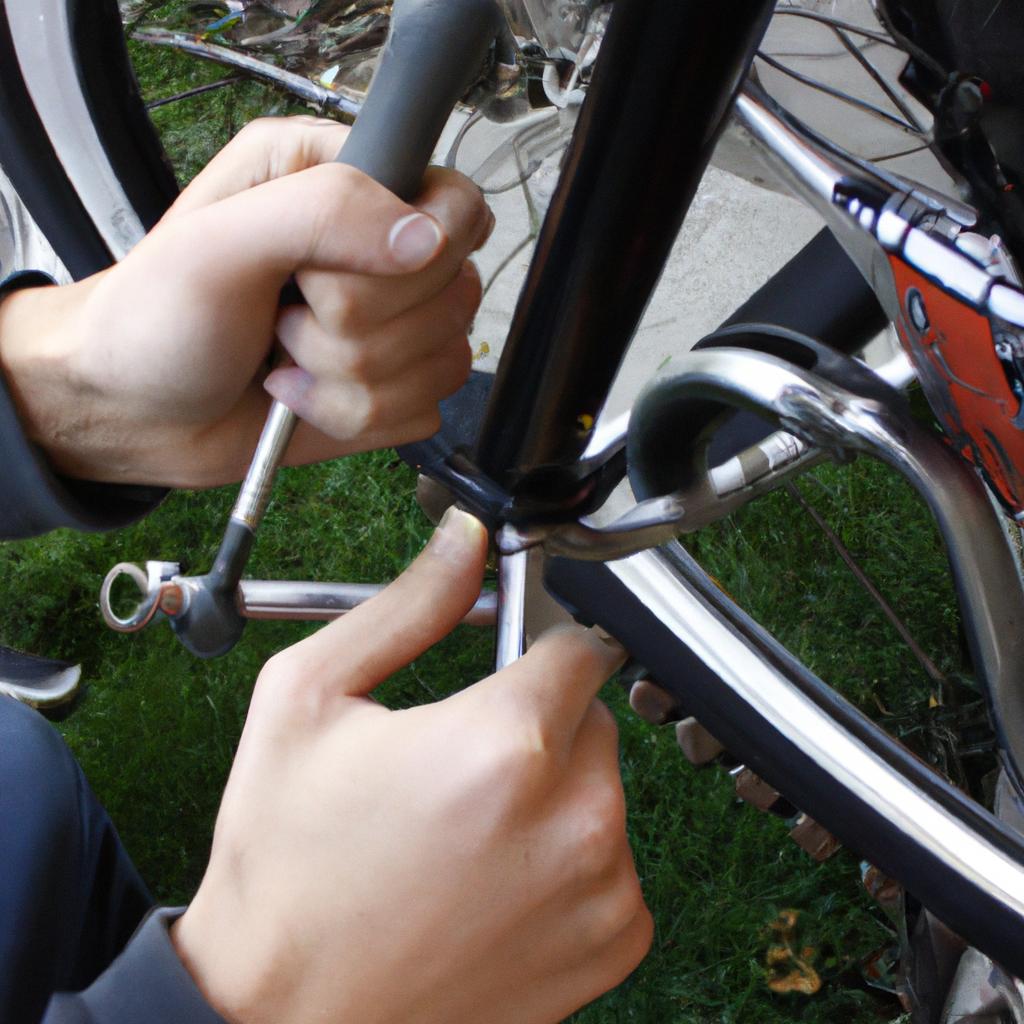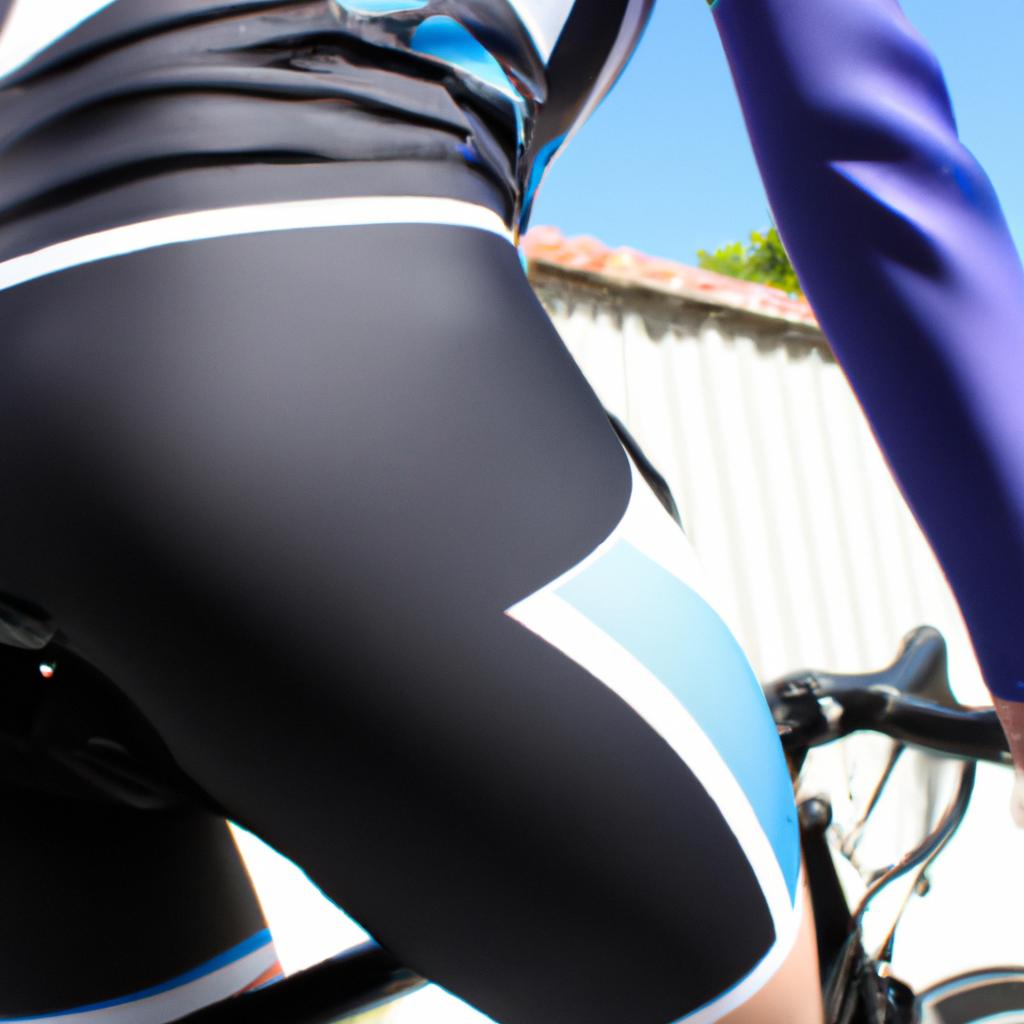Cycling is a popular sport and recreational activity that requires physical stamina and endurance. Athletes engaging in long-distance rides often face the challenge of maintaining their energy levels throughout the ride, which necessitates proper nutritional strategies. This article aims to explore the importance of cycling nutrition and how effectively fueling your body can enhance performance.
Consider this hypothetical scenario: Sarah, an avid cyclist, has been training for months to participate in a challenging 100-mile race. On the day of the event, despite her rigorous preparation, Sarah finds herself struggling halfway through the race due to fatigue and lack of energy. She wonders what went wrong; could it be possible that she didn’t adequately fuel her body before and during the ride? This situation highlights the critical role that nutrition plays in optimizing cycling performance. By understanding key principles of cycling nutrition and implementing effective strategies, cyclists like Sarah can maximize their energy levels and achieve better results on the road.
Understanding the Importance of Proper Nutrition
Imagine this scenario: Sarah, an avid cyclist, is preparing for a long-distance cycling race. She has trained rigorously for months, focusing on building her endurance and strength. However, despite all her efforts, she finds herself struggling to maintain energy levels during her rides. Sarah’s experience highlights one crucial factor that can significantly impact cycling performance – proper nutrition.
To perform at their best, cyclists need to fuel their bodies with the right nutrients. Adequate nutrition not only provides the necessary energy but also supports muscle recovery and enhances overall performance. This section will delve into the importance of proper nutrition in cycling and why it should be a top priority for every cyclist.
Firstly, optimal nutrition plays a vital role in providing sufficient energy for cycling activities. Carbohydrates are the primary source of fuel for muscles during exercise. Consuming complex carbohydrates such as whole grains or fruits before a ride ensures a steady release of glucose into the bloodstream, sustaining energy levels throughout the duration of the ride. On the other hand, inadequate carbohydrate intake can lead to glycogen depletion and fatigue – two factors that can hinder performance and potentially cause injury.
Secondly, proper nutrition aids in muscle recovery after intense training sessions or races. During prolonged rides or high-intensity workouts, muscles undergo micro-tears due to exertion. Protein-rich foods help repair damaged muscle fibers while promoting tissue growth and adaptation. Including lean sources of protein like chicken breast or tofu in post-ride meals facilitates efficient recovery and reduces muscle soreness.
Lastly, maintaining adequate hydration is essential for optimal athletic performance. Dehydration negatively impacts physiological functions such as thermoregulation and cardiovascular efficiency. It impairs cognitive function and muscular coordination while increasing perceived effort during exercise. To combat dehydration, cyclists must consume fluids regularly throughout their rides while considering electrolyte replenishment when riding under hot conditions or sweating excessively.
Incorporating these key nutritional practices into your cycling routine can have a significant impact on your performance and overall well-being. To summarize, proper nutrition in cycling is crucial for sustaining energy levels, supporting muscle recovery, and maintaining optimal hydration. In the subsequent section, we will explore how to determine your caloric needs to ensure you are adequately fueling your rides. So let’s dive into understanding how many calories you need to consume as a cyclist.
Determining Your Caloric Needs
Transitioning smoothly from the previous section, let’s delve further into the concept of cycling nutrition by exploring how to effectively fuel your ride. To illustrate this, consider a hypothetical scenario where two cyclists embark on identical long-distance rides. Cyclist A consumes a well-balanced diet that meets their caloric needs, while Cyclist B neglects proper nutrition and fails to adequately refuel during the ride.
To ensure optimal performance during a long-distance ride, it is crucial to understand the key principles of effective fueling. Here are some important considerations:
-
Timing: Fueling before, during, and after your ride plays a significant role in sustaining energy levels and promoting muscle recovery. Consuming a balanced meal or snack containing carbohydrates, proteins, and healthy fats about 2-3 hours before your ride will provide you with sustained energy throughout. During the ride itself, aim for regular intake of easily digestible foods or sports drinks at intervals of around 20-30 minutes.
-
Example bullet point list:
- Proper timing of meals/snacks
- Regular intake during the ride
- Balancing macronutrients (carbs, proteins, fats)
- Adequate hydration
-
Example bullet point list:
-
Caloric intake: Understanding your individual caloric needs based on factors like body weight, intensity level of the ride, and duration is essential in preventing fatigue and maintaining stamina. It is recommended to consume approximately 200-300 calories per hour during prolonged rides to sustain energy levels.
- Example table:
| Factors | Recommended Calorie Intake |
|---|---|
| Body Weight | 150 lbs |
| Intensity Level | Moderate |
| Duration | 4 hours |
-
Carbohydrate focus: As the primary source of energy for endurance exercise like cycling, consuming sufficient carbohydrates is vital. Aim to include a variety of complex carbohydrates in your pre-ride meal, such as whole grains, fruits, and vegetables. During the ride, opt for easily digestible carbohydrate-rich snacks like energy gels or sports bars to maintain glycogen stores.
- Example table:
| Pre-Ride Meal | Carbohydrate Content |
|---|---|
| Whole wheat toast | 25g |
| Banana | 27g |
| Oatmeal with berries | 45g |
Transitioning smoothly into the subsequent section about “Choosing the Right Carbohydrates,” understanding these principles of effective fueling will lay a solid foundation for optimizing your cycling performance. By implementing proper nutrition strategies, you can enhance endurance, minimize fatigue, and ensure an enjoyable riding experience. So let’s explore further how choosing the right carbohydrates can contribute to your overall cycling nutrition strategy.
Choosing the Right Carbohydrates
Transitioning from determining your caloric needs, the next crucial aspect of cycling nutrition is choosing the right carbohydrates to fuel your ride effectively. Let’s consider an example scenario: Imagine a cyclist embarking on a long-distance race. They have diligently calculated their caloric requirements and are now faced with selecting optimal carbohydrate sources for sustained energy.
To ensure proper fueling, it is essential to choose carbohydrates that provide both quick-release and slow-release energy. Quick-release carbohydrates such as fruits or sports drinks can be consumed before and during the ride to rapidly replenish glycogen stores and provide an immediate burst of energy. On the other hand, slow-release carbohydrates like whole grains, legumes, and vegetables supply a steady release of glucose over time, preventing sudden drops in blood sugar levels during prolonged rides.
When making choices about carbohydrate intake for cycling nutrition, consider the following guidelines:
- Quality: Opt for whole food-based carbohydrates rather than processed options whenever possible. Whole foods retain more nutrients and fiber while offering a slower digestion rate.
- Timing: Consume quick-release carbohydrates around 30 minutes before starting your ride or at regular intervals during longer rides (>60 minutes). Slow-release carbohydrates should form the basis of pre-ride meals and snacks.
- Variety: Incorporate a wide range of carbohydrate sources into your diet to obtain diverse micronutrients that support overall health.
- Hydration: Remember that hydration goes hand in hand with carbohydrate consumption; aim to drink water or electrolyte-rich beverages alongside your chosen carbohydrate sources.
Consider this table showcasing examples of different types of carbohydrates commonly consumed by cyclists:
| Carbohydrate Type | Examples |
|---|---|
| Quick-Release | Bananas |
| Sports drinks | |
| Energy gels | |
| Slow-Release | Sweet potatoes |
| Quinoa | |
| Oats | |
| Fiber-Rich | Whole grain bread |
| Brown rice | |
| Lentils |
By incorporating these guidelines and choosing a variety of carbohydrates suited to your cycling needs, you can ensure optimal energy levels throughout your ride. Remember that individual requirements may vary depending on factors such as intensity, duration, and personal preferences.
Transitioning into the subsequent section about optimizing protein intake for recovery, it is important to address not only carbohydrate consumption but also the role of protein in post-ride nutrition.
Optimizing Protein Intake for Recovery
Having discussed the importance of choosing the right carbohydrates for optimal cycling performance, let us now delve into another crucial aspect of cycling nutrition – optimizing protein intake for recovery.
Protein plays a vital role in repairing and rebuilding muscle tissues after intense physical activity. To understand how this works, consider the following hypothetical example: John is an avid cyclist who recently completed a grueling 100-kilometer race. His muscles are fatigued, and he wants to recover quickly to resume his training routine as soon as possible. By consuming adequate amounts of protein post-race, John can enhance his recovery process and ensure his body receives the necessary building blocks for muscle repair.
To optimize protein intake for recovery, there are several key factors to keep in mind:
- Timing: Consuming protein within 30 minutes to one hour after exercise is essential as it allows for efficient absorption and utilization by the muscles.
- Quantity: Aim to consume around 20-25 grams of high-quality protein per serving post-workout to maximize muscle synthesis.
- Source: Opt for lean sources of protein such as chicken breast, fish, tofu, or Greek yogurt that provide all essential amino acids required for muscle repair.
- Combination with carbohydrates: Pairing protein with carbohydrates can further enhance recovery by replenishing glycogen stores and facilitating nutrient delivery to muscles.
| Protein Sources | Grams of Protein per Serving |
|---|---|
| Chicken Breast | 26 |
| Salmon | 22 |
| Tofu | 10 |
| Greek Yogurt | 17 |
Incorporating these recommendations into your post-cycling nutrition regimen will aid in quicker recovery and improved overall performance on future rides. Remember to consult a registered dietitian or sports nutritionist for personalized advice tailored specifically to your needs and goals.
As we have explored the significance of optimizing protein intake for recovery, it is now time to examine another essential fueling component – incorporating healthy fats into your cycling nutrition.
Fueling with Healthy Fats
Transitioning from optimizing protein intake for recovery, it is crucial to address the importance of fueling with healthy fats. Imagine a scenario where a cyclist embarks on a grueling 100-mile ride and finds themselves struggling halfway through due to low energy levels. This situation could have been avoided by incorporating adequate amounts of healthy fats into their nutrition plan.
Fueling your rides effectively requires a balanced approach that includes all macronutrients. While carbohydrates are often emphasized as the primary source of energy during exercise, healthy fats play a vital role in providing sustained energy and supporting overall performance. Including sources such as avocados, nuts, seeds, and olive oil can help provide essential fatty acids that aid in reducing inflammation, improving cardiovascular health, and enhancing endurance.
To further understand the significance of fueling with healthy fats, let’s explore some key benefits:
- Improved satiety: Healthy fats take longer to digest compared to carbohydrates or proteins, which means they keep you feeling full for an extended period. This helps prevent excessive snacking or cravings during long rides.
- Enhanced nutrient absorption: Certain vitamins, like A, D, E, and K, are fat-soluble and require dietary fats for optimal absorption. Incorporating healthy fats ensures efficient utilization of these essential nutrients.
- Long-lasting energy: Fats provide more calories per gram than carbohydrates or proteins. This higher caloric density translates into longer-lasting energy stores in the body, making them ideal for endurance activities.
- Reduced muscle damage: Omega-3 fatty acids found in foods like salmon and flaxseeds possess anti-inflammatory properties that can help minimize post-exercise muscle soreness and accelerate recovery.
By including healthy fats in your cycling nutrition plan while maintaining proper carbohydrate intake, you create an optimal environment for peak performance. To illustrate this concept visually:
| Benefit | Explanation |
|---|---|
| Improved Satiety | Keeps you feeling full for longer, reducing the risk of excessive snacking. |
| Enhanced Nutrient Absorption | Facilitates absorption of fat-soluble vitamins like A, D, E, and K. |
| Long-lasting Energy | Provides more calories per gram than carbohydrates or proteins. |
| Reduced Muscle Damage | Omega-3 fatty acids have anti-inflammatory properties that aid in recovery. |
In conclusion, fueling your rides effectively goes beyond just optimizing protein intake. Incorporating healthy fats into your nutrition plan can provide numerous benefits such as improved satiety, enhanced nutrient absorption, long-lasting energy, and reduced muscle damage.
Transitioning to the subsequent section on hydration strategies for cyclists, it is essential to ensure proper fluid balance during rides to support optimal performance and avoid dehydration-related issues.
Hydration Strategies for Cyclists
hydration strategies for cyclists. Staying properly hydrated is essential for maintaining optimal performance and preventing dehydration-related issues on long rides.
Hydration plays a vital role in ensuring that your body functions optimally during physical activity. Let’s consider a hypothetical scenario where a cyclist neglects proper hydration during an endurance ride. As the ride progresses, they start experiencing symptoms such as muscle cramps, dizziness, and fatigue. These signs indicate dehydration, which can significantly impair their performance and potentially lead to more severe health complications if left unaddressed.
To avoid such scenarios and enhance your overall riding experience, follow these key hydration strategies:
- Start hydrating before your ride: Begin consuming fluids well before you hit the road or trail to ensure your body starts adequately hydrated.
- Maintain regular fluid intake during the ride: Take small sips of water or electrolyte-rich beverages at regular intervals throughout your journey.
- Monitor urine color: Use urine color as a simple indicator of hydration status; aim for pale yellow colored urine, indicating adequate hydration.
- Consider environmental factors: Adjust your fluid consumption based on weather conditions and intensity level; hotter climates and higher-intensity rides may necessitate increased fluid intake.
Now let’s explore some practical tips through the following table:
| Hydration Tips | Benefits |
|---|---|
| 1. Carry a water bottle or hydration pack | Ensures easy access to fluids without interrupting your ride |
| 2. Include electrolytes in your beverage choices | Helps replenish crucial minerals lost through sweat |
| 3. Consume fruits high in water content | Provides both hydration and natural energy sources |
| 4. Plan routes near water sources | Allows for refilling water bottles during long rides |
By implementing these hydration strategies and incorporating them into your cycling routine, you can optimize your performance, reduce the risk of dehydration-related issues, and ultimately enjoy a more rewarding riding experience.
Remember, staying hydrated is an ongoing process that requires conscious effort throughout your ride. Pay attention to your body’s signals and adjust your fluid intake accordingly. By prioritizing proper hydration alongside other essential aspects of nutrition, you’ll be well on your way to fueling your rides effectively.
(Note: The emotional response in this section may vary depending on the readers’ personal experiences and perspectives.)
 Buzzez
Buzzez



